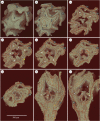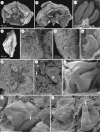The emergence of core eudicots: new floral evidence from the earliest Late Cretaceous
- PMID: 28003443
- PMCID: PMC5204160
- DOI: 10.1098/rspb.2016.1325
The emergence of core eudicots: new floral evidence from the earliest Late Cretaceous
Abstract
Eudicots, the most diverse of the three major clades of living angiosperms, are first recognized in the latest Barremian-earliest Aptian. All Early Cretaceous forms appear to be related to species-poor lineages that diverged before the rise of core eudicots, which today comprise more than 70% of angiosperm species. Here, we report the discovery of a well-preserved flower, Caliciflora mauldinensis, from the earliest Late Cretaceous, with unequivocal core eudicot features, including five sepals, five petals and two whorls of stamens borne on the rim of a floral cup containing three free carpels. Pollen is tricolporate. Carpels mature into follicular fruitlets. This character combination suggests a phylogenetic position among rosids, but more specific assignment is precluded by complex patterns of character evolution among the very large number of potentially relevant extant taxa. The whorled floral organization is consistent with ideas that this stable pattern evolved early and was a prerequisite for more integrated patterns of floral architecture that evolved later. However, limited floral synorganization in Caliciflora and all earlier eudicot flowers recognized so far, calls into question hypotheses that substantial diversification of core eudicots had already occurred by the end of the Early Cretaceous.
Keywords: SRXTM; asterid; fossil flower; rosids; synchrotron X-ray microtomography; tricolporate pollen.
© 2016 The Authors.
Figures





Similar articles
-
A eudicot from the Early Cretaceous of China.Nature. 2011 Mar 31;471(7340):625-8. doi: 10.1038/nature09811. Nature. 2011. PMID: 21455178
-
Two early eudicot fossil flowers from the Kamikitaba assemblage (Coniacian, Late Cretaceous) in northeastern Japan.J Plant Res. 2017 Sep;130(5):809-826. doi: 10.1007/s10265-017-0945-1. Epub 2017 May 11. J Plant Res. 2017. PMID: 28497291
-
Cretaceous chloranthoids: early prominence, extinct diversity and missing links.Ann Bot. 2024 Apr 10;133(2):225-260. doi: 10.1093/aob/mcad137. Ann Bot. 2024. PMID: 38597914 Free PMC article.
-
Missing links: the genetic architecture of flowers [correction of flower] and floral diversification.Trends Plant Sci. 2002 Jan;7(1):22-31; dicussion 31-4. doi: 10.1016/s1360-1385(01)02098-2. Trends Plant Sci. 2002. PMID: 11804823 Review.
-
Diversity in obscurity: fossil flowers and the early history of angiosperms.Philos Trans R Soc Lond B Biol Sci. 2010 Feb 12;365(1539):369-82. doi: 10.1098/rstb.2009.0227. Philos Trans R Soc Lond B Biol Sci. 2010. PMID: 20047865 Free PMC article. Review.
Cited by
-
Recurrent Plant-Specific Duplications of KNL2 and Its Conserved Function as a Kinetochore Assembly Factor.Mol Biol Evol. 2022 Jun 7;39(6):msac123. doi: 10.1093/molbev/msac123. Online ahead of print. Mol Biol Evol. 2022. PMID: 35671323 Free PMC article.
-
A high-quality Buxus austro-yunnanensis (Buxales) genome provides new insights into karyotype evolution in early eudicots.BMC Biol. 2022 Oct 4;20(1):216. doi: 10.1186/s12915-022-01420-1. BMC Biol. 2022. PMID: 36195948 Free PMC article.
-
Cretaceous asterid evolution: fruits of Eydeia jerseyensis sp. nov. (Cornales) from the upper Turonian of eastern North America.Ann Bot. 2019 Feb 15;123(3):451-460. doi: 10.1093/aob/mcy170. Ann Bot. 2019. PMID: 30212854 Free PMC article.
-
The Core Eudicot Boom Registered in Myanmar Amber.Sci Rep. 2018 Nov 13;8(1):16765. doi: 10.1038/s41598-018-35100-4. Sci Rep. 2018. PMID: 30425298 Free PMC article.
-
The Aquilegia genome reveals a hybrid origin of core eudicots.Genome Biol. 2019 Nov 28;20(1):256. doi: 10.1186/s13059-019-1888-8. Genome Biol. 2019. PMID: 31779695 Free PMC article.
References
-
- Friis EM, Crane PR, Pedersen KR. 2011. Early flowers and angiosperm evolution, pp. 1–585. Cambridge, UK: Cambridge University Press.
-
- Mohr BAR, Bernardes-de-Oliveira MEC, Loveridge RF. 2007. The macrophyte flora of the Crato Formation. In The Crato fossil beds of Brazil: window into an ancient world (eds Martill DM, Bechly G, Loveridge RF), pp. 537–565. Cambridge, UK: Cambridge University Press.
-
- Mendes MM, Grimm GW, Pais J, Friis EM. 2014. Fossil Kajanthus lusitanicus gen. et sp. nov. from Portugal: floral evidence for Early Cretaceous Lardizabalaceae (Ranunculales, basal eudicot). Grana 53, 283–301. (10.1080/00173134.2014.932431) - DOI
-
- Friis EM, Grimm GW, Miguel Mendes MM, Pedersen KR. 2015. Canrightiopsis, a new Early Cretaceous fossil with Clavatipollenites-type pollen bridge the gap between extinct Canrightia and extant Chloranthaceae. Grana 54, 184–212. (10.1080/00173134.2015.1060750) - DOI
-
- Friis EM, Pedersen KR, Schönenberger J. 2006. Normapolles plants: a prominent component of the Cretaceous rosid diversification. Plant Syst. Evol. 260, 107–140. (10.1007/s00606-006-0440-y) - DOI
MeSH terms
Associated data
LinkOut - more resources
Full Text Sources
Other Literature Sources

